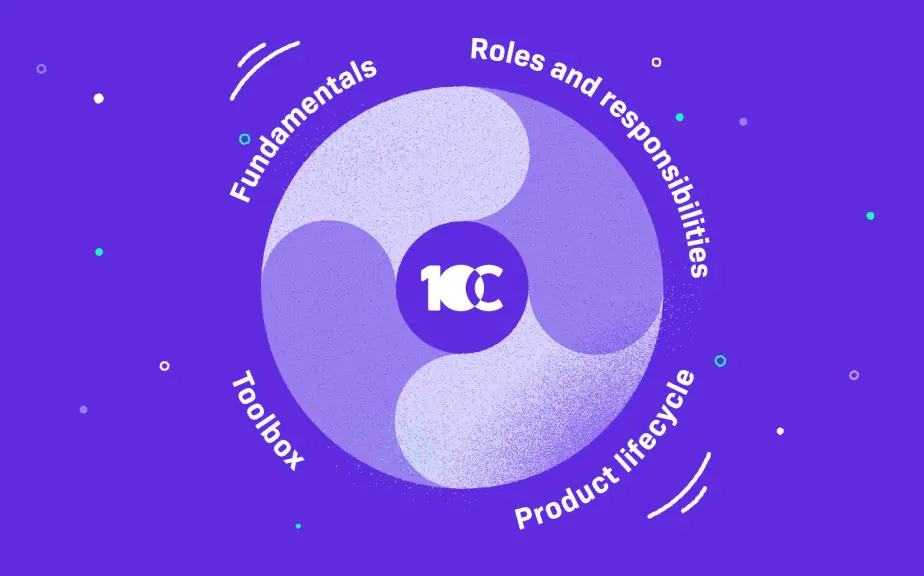a playbook
10C Agile Product Delivery Method
What you will learn
 Devising the product approach to fit the market besthow to turn your product idea into market reality
Devising the product approach to fit the market besthow to turn your product idea into market reality Organising the work to get resultshow to set up delivery work in a transparent and efficient way, with quick time-to-market in mind
Organising the work to get resultshow to set up delivery work in a transparent and efficient way, with quick time-to-market in mind Efficient kick-off of the workusing the team's full ability to develop your product
Efficient kick-off of the workusing the team's full ability to develop your product Getting the right qualityhow to integrate quality into product delivery
Getting the right qualityhow to integrate quality into product delivery
How our Product Delivery Method helped our clients
(selected from Clutch.co)
Introduction
Successful products have one thing in common: a method for creating and refining their scope, as well as a disciplined, value-driven way of delivering them. In this playbook, we will explain what the product delivery process at 10Clouds looks like and the benefits that it can bring your business - beginning with successful product launches. We will clearly explain the goals and value of every phase, the roles and responsibilities of the people involved, the tools and methods used and the level of engagement needed from your side to effectively collaborate in product creation.
In our approach, we draw heavily from well-established frameworks including Scrum and Kanban. Putting our many years of experience to good use, we integrate them with our best practices around external collaboration, working in a remote environment and managing distributed teams. Because we are agile, we can respond quickly to changes, allowing you to control the delivery process.
“Product Delivery is at the heart of our business. We are reliable partners throughout the whole product lifecycle, supporting our customers to build products and services that deliver real value to their end users and achieve market success”
The value of 10Clouds Agile Delivery Method vs other approaches
Over the last two decades, Agile approaches have continuously proven to be more efficient in software development than traditional ones - which is something that we’ve personally observed when working with clients. They enable the best use of the team’s potential. This is why we’ve built our 10C Methodology on Agile values and principles.
Here are just some of the benefits that you reap from Agile working:
- Higher rates of successful product delivery
- Shorter time to market
- Better product quality
- Adapting the product to changing market/user needs
- Increased customer/end-user satisfaction
- Increased project transparency
- Easier risk management
A lot of these benefits will also bring down your product’s Total Cost of Ownership (TCO).
To make sure that our clients also benefit from Agile, we draw inspiration from leading frameworks such as Scrum or Kanban, especially when it comes to the delivery process.
However, at 10Clouds we felt the need to make the delivery approach more product-centric and put the product value at the forefront explicitly. While the leading agile frameworks do highlight the crucial relevance of proper product management, too often their actual real-life usage does not treat this aspect seriously enough, focusing more on process mechanics.
Therefore, we believe that 10Clouds Agile Delivery Method serves our clients better. Below are just some of the additional benefits that it delivers:
- Applying the 10C Agile Delivery Method and utilizing reusable components can increase the product Completion Ratio by 30% and reduce Development Costs by 25%.
Excellent agile planning and prioritization methods make it possible to build the most important product features and instantly test them on the market. Getting faster insights means lower overall cost of the development, as well as improved and faster results.
Whenever it’s reasonable, we aim to apply reusable components. Based on our years of experience, we designed pre-existing starters for frontend layouts and infrastructure that speed up the development by weeks. This means that the process of setting up environments now takes a few hours instead of a couple of days. - The product value focus and continuous discovery
We have made sure that good product management is central to every step of the product's life cycle. A lot of articles and books in recent years have pointed out the shortcomings of leading frameworks in the area of product management; our approach addresses these issues. With 10Clouds, you also have access to a great UX Research team that shares its knowledge and best practices with the 10Clouds Product Delivery Management (PDM) team. - Flexibility while drawing from best industry practices
We have taken the elements that we found useful from various industry best practices, and combined them with tested methods and standards from our projects. We’re not dogmatic in applying schemes and procedures that may be unnecessary or cumbersome, and which might take time and money from our clients. - PDM as a delivery partner
To better support the product-centricity of our delivery process, we have defined the role of PDM as a natural extension of the Scrum Master or Agile PM role. With the PDM, the Product Owner (PO) on the client's side gains an experienced partner with good product management skills, who can help drive the value of the product throughout its lifecycle. Our PDM team possesses a wealth of knowledge in process and product management, which enables us to effectively serve our clients. - Project health framework
In all our projects, we want to be transparent and proactive in risk management, which is why we have defined a lightweight set of standards and practices that we follow. This will give you peace of mind about the project's progress and future. - 10Clouds Enabling Team (Tech Hub)
The Enabling Team consists of Tech Leaders who help set up projects based on company standards and support initial tech-related assumptions and decisions, removing any roadblocks that would appear further down the road. The idea is to make sure that the Development Team members don’t lose focus on unnecessary distractions. Our ultimate goal is to provide you with the highest quality technical solutions based on our 12+ years of experience and modern technology.
A combination of agile methodology with a product-centric angle reduces risks and supports effective product launches, which inspire confidence.
10C Agile Delivery Method overview

Fundamentals
the basic principles and values
Roles and responsibilities
the roles and responsibilities of every team member
Product lifecycle
a description of practices, tools and goals for each phase
Toolbox
a summary of the various tools and practices used to drive efficient product delivery
Fundamentals

10Clouds Product Delivery is:
Product-centric
Supporting our clients in shipping valuable products is the ultimate goal of 10Clouds and the main focus for the Product Delivery Management team. We always strive to create solutions that your users genuinely benefit from, rather than just adding features. We also help you see the bigger picture as we look beyond the initial delivery and help you understand how your choices will affect your future scalability, maintainability, and flexibility. We promise to help you go through every step of the software delivery process.
Depending on the product phase, we can also provide support in building your product’s value proposition, verifying value hypotheses, and conducting tests with real users. All of this can significantly improve the product’s quality, market fit, and raise the chance of achieving business success.
Agile and Lean
We are Agile which means we always use a transparent delivery process that allows for new ideas and short release cycles. At the same time, we are also applying Lean principles by reducing waste, maximizing the efficiency of cost and effort, focusing on quality, learning, and empowering our teams.
Thanks to the unique combination of Agile and Lean principles, we are able to maximize business value, while minimizing the chance of failure and making sure that resources are used effectively throughout the lifecycle of a product.
Lightning Fast
We are business-oriented, so we encourage you to test your product during the discovery phase, which is cheaper and quicker than doing it post development. This lets you validate your business ideas, get immediate feedback from stakeholders, and feel more confident that you're headed in the right direction. It also means that we take weeks to deliver results, rather than months and years.
In addition, we use our technical expertise to streamline the delivery work - our Tech Leads gathered in the Tech Hub (10C Enabling Team) will suggest reusable approaches, off-the-shelf components and software delivery practices.
Tailored to you
We go beyond adjusting our product delivery approach to your needs. We also use our wide experience to support you to define product strategies and roadmaps adapted to your market. We are able to tailor our approach to suit you and your product in a way that will result in ultimate business success.
Delivery Manifesto
Delivery Manifesto
Product delivery
over project delivery
Flexibility in action
over defined roles
Trust and accountability
over low-level management
Delivering value
over delivering scope
Extreme ownership
over areas ownership
Competencies
over processes
Focusing on product over project delivery and value over scope puts us in a strong position to build projects that are useful and ultimately successful.
We put flexibility, competencies, trust and ownership at the forefront of our principles to achieve success in Agile collaboration partnerships.
10C Product lifecycle overview
We are aware that creating a successful product does not start with development. A good outcome mostly depends on the quality of the preceding stages. Most failures can be attributed to a lack of product-market fit. This can be fixed with solid market research, rapid testing, pivots and continuous discovery.
Then, development itself requires a different approach depending on the business maturity of your product.
Our team is fully aware of what needs to be done at every stage of product delivery. We work with companies at every stage of the product lifecycle: from defining product strategy, validating the idea on the market with a prototype, testing a product with an MMP, to finding a product-market fit, scaling it, and finally, sustaining market share.
We use the 10C product delivery lifecycle as a starting point for working with our clients. At the initial stage of cooperation we carefully analyze:
- your business needs and goals
- the biggest challenges you’re facing right now
- the current status of the product
- your time to market expectations
Thanks to this we know exactly which phase of the lifecycle your product is in, and we can offer you the most suitable model of cooperation.
You can find the full product lifecycle overview below.

INSIGHT | Market insight strategy
Goal: Understanidng market landscape
Focus: Researching and analyzing the market, defining product strategy
10C approach: Product strategy consulting

DISCOVERY | PROTOTYPE
Goal: Validating product idea on the market
Focus: Adapting rapidly to new insights from customers and the market
10C approach: Product discovery phase

INTRODUCTION | MMP
Goal: Launching the first version of the product
Focus: Developing the solution and preparing metrics to validate your business assumptions
10C approach: 2-months MMP development

GROWTH | Product Scaling
Goal: Taking full advantage of the market opportunities
Focus: Supporting growing numbers of users while optimizing technical solution
10C approach: Data-driven development

MATURITY | Maintenance
Goal: Sustaining market share
Focus: Customer satisfaction and battling churn.
10C approach: Cost optimization
Taking consecutive steps and anticipating what will be needed at the current and next stages of the product process help increase our chances of success.
Planning resources for Continuous Discovery, including further stages like product maintenance, is essential to product ownership throughout its lifecycle.
Product lifecycle overview - 01
Insight Stage
This is the starting point for customers who have a general product idea. This phase is about verifying whether the problem that you are looking to solve is worth the effort.
Overview
During this stage the team (which involves both you - the client and 10Clouds) will work on understanding the problem, verify how big and important it is and understand who the clients/end users are. The team will also start defining how the product can solve this problem, what other solutions are already on the market and how the product can provide value to future clients.
Goal
In this stage, we aim to understand the market in general and define the product strategy based on the market research. The goal is to create the product strategy that will allow further work on your product to be efficient and aimed at value creation, taking into account the market and potential users.
Value
- Creating a successful product is not possible without understanding the problems we want to solve. The better the team understands these problems, needs, pain points, personas etc. the more likely it is that they will come up with a valuable product.
- Initial verification of clients’/users’ needs and problems and defining personas is the first step to involving clients or users in product development.
- You gain a business partner instead of a (purely technical) delivery partner.
10Clouds approach
The Insight phase is built around workshops and research. Most of the exercises used by consultants, UX researchers, product designers, and technical experts come from the Design Thinking and Lean Startup approaches. On your side, you need to have people with knowledge about the market, product vision, target customer groups and end users. Together we will identify what we know and in which areas more research is needed, especially involving the end users.
The duration of the Insight Phase depends on the product complexity and the need for research. On average it can last 3 - 6 weeks.
Outputs (at minimum the following):
Outcomes:
A good understanding of the product's value to customers increases the chances of a better market fit of the end product.
It also lets you pause, to adjust your approach or pivot the work on the product.
You’ll be able to greenlight the next work based on actual insights rather than on a hunch.
Product lifecycle overview - 02
Discovery Stage
This is a starting point for customers who have already defined their product strategy and want to pursue the product further without investing in development.
Overview
During this stage the team (which includes you - the client - and 10Clouds) undertakes to test the initial product strategy in the market involving future customers to see if our solution is worth building. The team needs to evaluate whether it correctly identified the core user problems and features that will be pain relievers or gain creators for them. The evaluation should be relatively quick and cost-effective, as well as iterative. The team will experiment, seeking product and market fit, while actually measuring it.
Value
- Full-fledged products are expensive to make and have a high chance of failing as they may not deliver enough value to customers. Using different early stage testing methods can help validate solutions on the market and reduce possible waste.
- This phase lets clients validate the value of the entire solution as well as the value of particular solution features. Users can suggest what to change or add to make your service more valuable.
- This is also a chance to get initial hints from the users on the UX side which can be later used when designing the product interface.
- You gain the opportunity to make changes and serve a real need in the market.
- With prototypes, you gain a valuable tool that you can use to attract investment.
- Confirming your assumptions is great for morale and can give you the motivation to keep going when things get tough.
10Clouds approach
This stage consists of workshops, research and design/development activities aimed at creating prototypes that can be tested. At this stage, we often use the Design Sprint framework. We engage UX researchers, product designers, developers, and Product Delivery Managers. You ought to involve the same people as in the Insight Stage, but with more focus on managing the interactions with end users - in some cases you might also coordinate and execute campaigns on social media for prototype testing etc.
The duration of the Insight Phase depends on the product complexity, required research and the number of end users involved. On average it can last 3 - 6 weeks.
Deliverables
Outputs:
Outcomes:
Market testing that includes prototyping, user validation and UX analysis prior to the full development cycle will save costs in the long run. One can save money through better decision making on the product scope and focusing on the features that are really needed to bring value to the end users.
Product lifecycle overview - 03 & 04
Product Delivery - Introduction and Growth Stages
In line with the principles of Lean and Agile, we strongly advise our clients to split the delivery into releases so that a Minimum Marketable Product (MMP) can be put on the market as soon as possible.
MMP is the first version of a product that can be released to the market as a proper product. It has a sufficient set of features to provide value to the users, but not all of them. This allows us to build up the user base, start making money on the product, test it and get relevant feedback from users, which is important for the future success of the product at the development stage.
The product roadmap (MMP and beyond) and initial backlog, based on the needs identified in the earlier phases, are kept up-to-date to ensure that the product is useful and delivers business value.
We believe that product management activities should be data-driven (which is why we will help you define and measure the right product metrics) and conducted in close collaboration with stakeholders, in particular the end users. This is why Continuous Discovery - encompassing the UX Research activities - needs to be part of the product delivery.
Goal
The goal is to deliver your product - first in the MMP version and then in further releases, based on data and inputs from internal and external stakeholders.
The goal of the MMP is to:
- put the product on the market and monetize it
- create a customer base
- gather feedback about the product and its further development
Following the MMP, the focus usually is on those areas:
- Increasing stability and scalability - making it robust and ready to grow
- Developing an enhanced version through a series of iterations
- Creating your own IP
Why do we recommend splitting into releases and starting with an MMP?
- Less time to launch
Building an MMP for a product is finding the sweet spot between the minimum work and maximum value. As a result, products will be delivered more quickly. - Less room for error
With the work split into smaller chunks, teams can test the solution earlier and take fewer project risks. As a consequence, a development team has less code to write and more time to experiment and iterate on the client's idea. - Budget-friendliness
An MMP makes it more affordable to start a business. - A chance to find investors and raise funding
An MMP can showcase the seed of what is expected to become a new and exciting product - which is particularly useful when trying to convince investors. - Establishing a customer base
Another reason behind developing an MMP is to make it available to real users. After you’ve released a product, the goal is to keep evolving and adapting it to the needs of your customers. Regardless of feedback, you’ll know if your product is ready for the market based on this information.
How do we organise the software delivery of the MMP and beyond?
10C Product Delivery is Agile - we draw from the Agile Manifesto and the leading agile frameworks, particularly Scrum and Kanban.
To ensure the quality of our collaboration with clients, we have a company-wide project health process that covers all of our projects. This encompasses team and client satisfaction, delivery health (budget, timeline and scope), as well as risk management.
We have also defined standards and practices for Product Delivery Managers to ensure that in all projects we properly deal with the following aspects that are relevant to the project’s success:
- Product (backlog) management
- Product quality
- Delivery process quality
- Communication and Transparency
- Team building
- Formalities and procedures
Project onboarding
In this phase, the Product Delivery Manager (PDM) liaises with you on the methods of collaboration. This includes:
Kick-off meetings
To ensure that everyone is on the same page around product goals, constraints and collaboration rules
Technical setup
environments, accesses, communication channels, etc
Product delivery setup
backlog creation and refinement
Product delivery
The delivery can be based on Scrum (with sprints - fixed-length events aimed at delivering a product increment) or Kanban (no sprints). The 10Clouds PDM will ensure that in both cases, all required elements of the process are happening and that the process is managed well to increase efficiency. We select the approach, taking into account the specifics of each product delivery. We’ve found that in most cases, the approach based on Scrum fits best.
The Product Owner on your side will manage the product roadmap and backlog, with the PDM’s support (more details in the section Roles and Responsibilities). Together with the team, as part of the project onboarding, you will define how the product backlog items should be described so that they are ready for development.
In projects that cover both design and development, especially ones that require heavily customised and complex design, we typically aim to start the work on design before engaging the developers. In this way, the designs serve as the basis for further refining the product backlog items together with developers.
However, we may advise our clients to start at the same time, especially if the user interface is simple and can be based on standard components or standard frameworks; in this way, it is possible to proceed with the delivery work more quickly and test the design ideas on actual screens.
Work cadence
Usually, we’re working in 2-week sprints, but depending on the specific product situation, the client and PDM can suggest a different duration. An example of a 2-week sprint cadence can look like this:
- Day 1
Daily meeting
Review, Retro, Planning - Day 2
Daily meeting - Day 3
Daily meeting
Product roadmap & backlog management (PO, Tech Lead, PDM) - Day 4
Daily meeting - Day 5
Refinement of backlog for next sprint(s) - Day 6
Daily meeting - Day 7
Daily meeting - Day 8
Daily meeting - Day 9
Daily meeting - Day 10
Daily meeting

At the end of the sprint, a new potentially shippable product increment is created and the client can decide to release a new version to end users.
During planning, the team and Product Owner discuss what the next sprint's goal should be and what items from the backlog should be taken to the sprint (tasks, bugs, user stories). The aim is to select the items that will bring the most value.
The team inspects its progress towards the sprint goal during daily meetings and uses that information to adjust the work plan.
The results of the work are presented in the review stage, which is also an opportunity to gather feedback and review the backlog, to verify priorities and value of the product backlog items.
The team then uses the retrospective meeting to discuss improvements to see how they work together.
During the sprint, we organize meetings dedicated to reviewing the roadmap and the backlog for the future sprints, and refining the latter, so that it is ready for further planning.
Progress tracking
Usually we use Jira for backlog management and defining the product backlog items (user stories, tasks). Our standard delivery process maintained in Jira allows to easily understand the status of work and helps ensure quality management as well as clear acceptance:
Each ticket needs to go through Code Review and through QA
After CR and QA, the ticket is ready for the Product Owner to review
In Jira, you will be able to see the status of individual backlog items as well as of the whole sprint. This transparency is crucial to the project's success.
On top of that, you can expect the PDM to provide you with updated information about the progress and budget consumption.
Project Health
All our projects are covered by the Project Health process which includes the following metrics:
- Delivery Health: scope, budget, time
- Client satisfaction
- Team satisfaction
- Risks
In case of any issues, the PDM and Account Manager, together with the assigned Project Owner from the 10Clouds management team, discuss and implement the required actions.
Quality assurance
We have a holistic view of product quality that encompasses several aspects:
Unit testing as development standard - our developers write tests to check the quality of their code.
Each piece of code is subject to the Code Review process.
Quality Assurance specialists are part of the Development team, to ensure functional testing; QA is embedded in the delivery process, each ticket should go through tests. On selected projects, automated testing is also added.
Each project either has a dedicated Tech Lead assigned and access to our Tech Hub - Enabling Team for consultation (more on that team in )
Developers document the code and technical documentation is created; our standards can be adjusted to specific client needs.
We use CI/CD setup to ensure our code can be deployed efficiently, securely and minimizing conflicts and regressions.
On each project, we proactively manage the technical debt.
We use the Definition of Done to verify if our deliverables can be safely released to production.
Definition of Done
Backend / Frontend branch for a feature
Code ready
Unit tests for happy path (minimal requirement)
Documentation for: env setup and standards, deployment, API and / or spec
Code review
QA on the merge request on the test environment
Bug fixed
Code merged
Deploy on stg
Regression tests
Deploy on prod
For all the points above - the task must meet the Acceptance Criteria
Differences between Introduction and Growth delivery models
The delivery process remains the same in Introduction and Growth phases, however there are some differences that you may expect:
More focus on performance and scalability, and potentially also on security, in the Growth phase (which also means adjusting the Definition of Done, which is how we decide if a product is ready to go into production)
More attention paid to technical debt in the Growth phase
More intense involvement of real end users and their feedback in creating the roadmap and defining new features or modifications in the Growth phase
Using a different set of product metrics that reflect different priorities between the two phases
The team composition (required specialties) may change between the two phases
Split the product into releases and start with a Minimum Marketable Product to make money earlier and gather timely feedback.
Agile values and principles are at the core of efficient collaboration.
The quality of the product requires more than just having testers in the team.
Product lifecycle overview - 05
Maintenance
After a product go-live that covers all currently required features, 10Clouds can support its ongoing maintenance.
The goals are:
- To keep the product in good shape so that it continues to satisfy clients and remain competitive
- To address market needs by small adjustments that let customers use a good quality product over a longer time/ during the product’s lifespan
- proactively managing infrastructure to manage the costs and performance
During the maintenance phase, we advise our customers to gather user feedback and actively verify if new features or modifications are required. It is also a chance to put on hold features that are not used to keep the solution simple and more scalable.
The monitoring scope can cover various types of monitoring services to quickly fix any availability issues, as well as upgrade certificates and other components to ensure that the product stays safe and up to date.
Handover to 10Clouds Maintenance Team is a defined process that ensures proper knowledge and documentation transfer; if there’s a need, the Maintenance Team can also reach out for consultation to developers that were involved in product development.
Together with your Account Executive / Account Manager, you will be able to define the scope and level of required maintenance support; for communication with the Maintenance Team, Jira Service Desk will be used, providing you with good visibility of issues and their statuses.
A good maintenance setup allows you to keep the product on the right track and enables further growth or pivots.
Maintenance and monitoring can be tailored to specific needs, so it is critical to understand your options and calibrate them.
Product Delivery - Roles and responsibilities
Since our approach is rooted in Agile values and principles, the core of 10Clouds product delivery is a self-managing team, supported by a Product Delivery Manager (PDM).
You will collaborate with:
- The Development Team
(Usually: developers, QA, QAA, designers, Devops) that is responsible for delivering a product aligned with the agreed upon quality standards, as well as for actively supporting product backlog management. In line with all agile approaches, we want the team to be autonomous - they get to decide how they will work on the product. - Tech Lead
For all projects, we provide the development team with the support of a senior developer who is able to define the technical architecture, including integrations, technical standards and practices, provide insights for the product roadmap and backlog management, as well as support the daily work of the developers for example via code reviews or consultations around development options, libraries, frameworks etc. If on your side there’s a software architect or a Tech Lead, 10Clouds Tech Lead will be their partner in defining and managing the technical excellence of the delivery. - A Product Delivery Manager
Who will, from 10Clouds’ side, drive efficient delivery of a valuable product. The PDM will set up and maintain the process and support good product management. This is a role that goes beyond that of a Scrum Master or Project Manager in its focus on product value. - Account Manager / Account Executive
Who will deal with all contractual matters and ensure smooth cooperation.
Additionally, the team will have access to the Tech Hub - Enabling Team composed of Tech Leaders for consultations during the project onboarding and throughout the development. This helps the team make code that is robust, easy to maintain, and scalable in the future.
From your side, we need a Product Owner, subject-matter experts as well as ensuring that the assumptions, prototypes and product iterations can be verified with the relevant stakeholders, including end users.
Our understanding of the Product Owner is derived from the Scrum Guide: the main responsibility is maximizing the value of the product. The Product Owner works on the product roadmap and backlog and is responsible for accepting (or giving feedback about) the work deliverables.
10Clouds’ PDM will be a partner for the PO in product management. For example, a PDM can take care of describing backlog items in Jira, preparing suggestions for the roadmap and backlog ordering, as well as suggesting ways of engaging stakeholders and measuring the product.
Product Delivery Toolbox
We use a set of best practices and standards in our daily work to make sure that our projects are run as quickly and productively as possible. All projects are covered by a Project Health process, allowing for transparent communication and quick decision loops around project metrics, including risks.
In addition, 10Clouds Product Delivery Managers work together as a team to increase their knowledge and skillset.
The 10Clouds Agile Method checklist covers the following main areas of interest whose execution quality we monitor:
To support our PDMs in their daily work, we have accumulated a plethora of tools and techniques for driving product delivery:
- Product management toolbox, incl. discovery techniques, prioritization techniques, tools like Story Mapping, refinement practices etc
- Workshops and project meetings facilitation toolbox
- Team collaboration toolbox
- Project Health metrics toolbox, incl. risk management
- And others
Setting up your product for success - how to start working with 10Clouds on your product
Our Sales and Presales teams will be in touch with you, to understand your product and your needs, so that we can select the collaboration model that is most fitting.
- Insight stage collaboration: if you have a general idea for your product, but have not yet done a lot of research to hone your product strategy.
- Discovery stage collaboration: if you want to verify your product strategy, define your product in more detail and test its prototype.
If you have already done the work from the Insight and Discovery stages, and you have materials like Lean Canvas, user personas, Value Proposition Canvas, and other product strategy related research results, and you are certain that those are sufficient to start working on the final product, we will suggest moving into the Delivery stage of the project.
We start our Delivery projects with Lean Inception - usually it takes one week for you and the team to establish all rules of cooperation and delve into the product scope. The shared understanding and awareness of the business context and goals will foster efficient delivery throughout the project. During this period, the team will work on the technical side to prepare for the start of the delivery phase. You can read more about Lean Inception in our blog post.
Based on the materials you provide and our conversations, the 10Clouds Presales team might suggest spending more time on honing and researching your product strategy. If that's the case, we will suggest a customised approach, such as a series of workshops or a longer "discovery" phase.
Summary
Key takeaways from the Playbook:
A combination of agile methodology and a product-centric angle makes it easier to launch products with less risk and more confidence.
Focusing on product over project delivery and value over scope puts us in a strong position to build projects that are useful and ultimately successful.
We put flexibility, competencies, trust and ownership at the forefront of our principles to achieve success in Agile collaboration partnerships.
Investing in good understanding of the underlying product value for its customers increases chances of better market fit of the end product.
It also lets you halt and change your plan or the way you work on the product.
You'll be able to give the go-ahead for the next project based on facts instead of a hunch.
Market testing, including prototyping, user validation, and UX analysis before starting the full development cycle, will save costs in the long run. This is due to better decision making on the product scope and focusing on the features that are really needed to bring value to the end users.
Split into releases and start with Minimum Marketable Product to utilize the opportunities to monetize early and gather timely feedback.
Agile values and principles are the core of efficient collaboration.
Quality of the product requires more than just having testers in the team.
A good maintenance setup allows you to keep the product on the right track and enables further growth or pivots.
Maintenance and monitoring can be adjusted to specific needs - it’s worth your time to recognize and fine-tune the options.
10Clouds has been delivering software since 2009. Our strategy leverages our expertise in consulting, design and technology to help businesses perform at the peak, so they can create long-term value for their customers and shareholders. Based on our extensive experience, we have established the most effective process to accelerate time-to-market, cut development costs, launch products successfully and maximize their return on investment.
We partner with our clients to help them build the right product for the right market - so that they can create a sustainable business around it. Modern application development requires more than a fantastic product idea; you must have an in-depth understanding of your users and customers to craft an effective product strategy. Our primary goal is to get the business value correct while minimizing the risk of failure.
We are an all-in-one partner who can support you throughout your business and product development journey.








